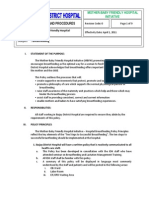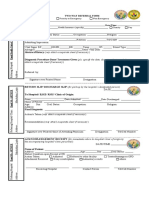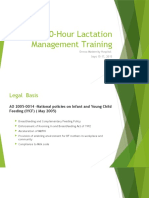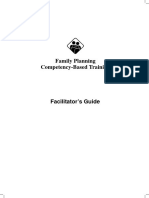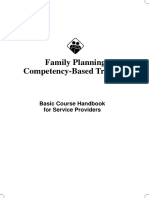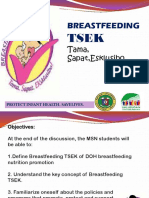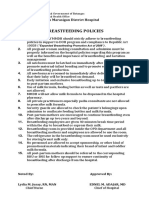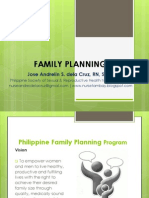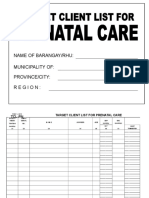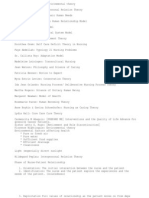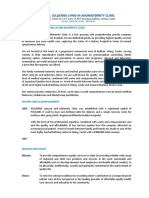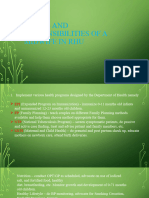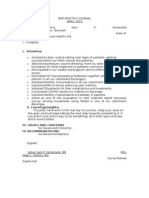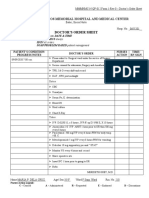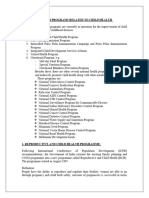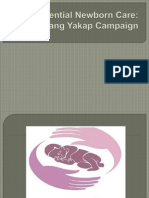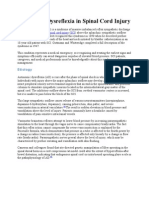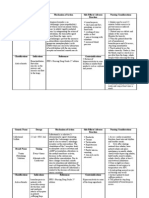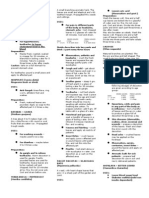95%(21)95% found this document useful (21 votes)
6K viewsAO 2009 0025 Essential Newborn Care
AO 2009 0025 Essential Newborn Care
Uploaded by
julesubayubay5428Program from DOH Philippines in Newborn Care
Copyright:
Attribution Non-Commercial (BY-NC)
Available Formats
Download as PDF, TXT or read online from Scribd
AO 2009 0025 Essential Newborn Care
AO 2009 0025 Essential Newborn Care
Uploaded by
julesubayubay542895%(21)95% found this document useful (21 votes)
6K views15 pagesProgram from DOH Philippines in Newborn Care
Copyright
© Attribution Non-Commercial (BY-NC)
Available Formats
PDF, TXT or read online from Scribd
Share this document
Did you find this document useful?
Is this content inappropriate?
Program from DOH Philippines in Newborn Care
Copyright:
Attribution Non-Commercial (BY-NC)
Available Formats
Download as PDF, TXT or read online from Scribd
Download as pdf or txt
95%(21)95% found this document useful (21 votes)
6K views15 pagesAO 2009 0025 Essential Newborn Care
AO 2009 0025 Essential Newborn Care
Uploaded by
julesubayubay5428Program from DOH Philippines in Newborn Care
Copyright:
Attribution Non-Commercial (BY-NC)
Available Formats
Download as PDF, TXT or read online from Scribd
Download as pdf or txt
You are on page 1of 15
Republic of the Philippines Department of Health
OFFICE OF THE SECRETARY
01 December 2009
ADMINISTRATIVE ORDER No. 2009 - 0025
SUBJECT
Adopting New Policies and Protocol on Essential Newborn Care
I. RATIONALE
The Philippines is one of the 42 countries accounting for 90% of all global deaths of under 5 year old children. Childhood death rates in the Philippines showed a downward trend from 1993 to 2003 with the decline slowing down in the last 10 years. The under five mortality rate (U5MR). decreased to only 32 per 1000 livebirths in 2003 from 52 per 1,000 live births in 1988. The infant mortality and child death rates exhibited similar trend over the same period. Neonatal and post-neonatal deaths declined the slowest over the past 20 years with the reduction of only 9 percent and 7 percent, respectively, from 1988 to 2003.
Further analysis of the neonatal deaths shows that half occur during the first 2 days or life. Birth asphyxia (31 %), complications of prematurity (30%) and severe infection (19%) account for the majority of newborn deaths. If newborn mortality is not reduced by at least hal L the goal of reducing childhood mortality by two thirds (Millennium Development Goal #4) by 2015 would not be met.
An observational study of consecutive deliveries using a standardized assessment tool to document minute-by-minute newborn care done in the first hour of life was undertaken in 51 hospitals in 9 regions of the country in 2008. The study found that Philippine hospital practices prevented newborns from benefitting from their mothers' natural protection in the first hour of life. Further, the performance and timing of evidence-based interventions in immediate newborn care are below WHO essential newborn care standards. Specifically:
• Only 3% of our study newborns were dried prior to or with cord cutting. and only 1 of 26 with difficult breathing was dried first. Hypothermia can lead to infection, coagulation defects, acidosis, delayed fetal to newborn circulatory adjustment, hyaline membrane disease and brain hemorrhage.
• Unnecessary delays and restrictions on immediate and sustained skin-to-skin contact, early latching on, rooming in and full breastfeeding compromised the newborns' chance for maintenance of warmth and sustained breastfeeding. These earliest interventions contribute to hospital infection control as they directly reduce risk of neonatal sepsis.
• Almost no newborn benefited from the natural transfusion through nonimmediate cord clamping. A Cochrane systematic review of 7 Randomized Controlled Trials (RCTs) showed that among infants less than 37 weeks of gestation, non-immediate cord clamping is associated with fewer transfusions due to anemia or low blood pressure and fewer intraventricular hemorrhages. Full-term neonates also benefit by having lower incidence of anemia.
• Only 61.3% of newborns was initiated to breastfeeding within the first hour.
However, newborns were given a median of only about two minutes to get colostrum, their first immunization. Furthermore, they were being forced to breastfeed at a median of 10 mins, long before the typical newborn would be ready.
• More than 80% was exposed to hypothermia during washing. The WHO recommends that initial bathing should be six hours after birth or longer. The vernix was washed off at a median of 8 minutes thereby removing a protective barrier to bacteria such as E. coli and Group B Strep. Furthermore, washing removes the crawling reflex.
• Virtually all healthy newborns were suctioned unnecessarily, 80% more than once - a practice WHO discourages.
Correct and appropriately-timed interventions given to the newborn during this period will benefit both the newborn and the mother as these will avert approximately 70% of avoidable newborn deaths. A package of services for newborn that follow a prescribed sequence of interventions increases newborn care effectiveness. This means that time-bound interventions are routinely performed first, non-time bound interventions are performed after time-bound ones, and unnecessary procedures are not performed.
This Administrative Order (AO) outlines specific policies and principles for health care providers with regard the prescribed systematic implementation of interventions that address health risks known to lead to preventable neonatal deaths. This AO is consistent with AO no. 2008-0029 on Implementing Health Reforms for Rapid Reduction of Maternal and Newborn Mortality and supports all DOH initiatives and programs for newborn and child health.
II. OBJECTIVES
In general, this policy aims to ensure the provision of globally accepted evidence-based essential newborn care focusing on the first week of life.
Specifically, it aims to:
(1) Guide health workers and medical practitioners in providing evidence-based essential newborn care
(2) Define the roles and responsibilities of the different DOH offices and other agencies in the implementation of the Newborn Protocol
2
III. SCOPE OF APPLICATION
This order shall apply to the whole hierarchy of the DOH and its attached agencies, other public and private providers of health care and development partners implementing the Maternal, Newborn and Child Health and Nutrition (MNCHN) strategy and to all health practitioners involved in maternal and newborn care.
IV. DEFINITION OF TERMS
1. Attachment - is the mode of contact between the baby's mouth and the mother's breast during the act of breastfeeding.
2. Kangaroo Mother Care - a universally available and biologically sound method of care for all newborns, but in particular for premature babies, with three components: a) skin-toskin contact, b) exclusive breastfeeding and c) support to the mother-infant dyad.
3. Newborn Resuscitation - a series of actions taken to establish normal breathing III a newborn with depressed vital signs
4. Positioning - means how the mother holds her baby to ensure proper attachment to each other.
5. Positive pressure ventilation - is the most important aspect of newborn resuscitation for ensuring adequate ventilation of the lungs, oxygenation of vital organs such as heart and brain, and initiation of spontaneous breathing.
6. Pregnancy, Childbirth, Postpartum and Newborn Care (PCPNC): A Guide for Essential practice in Philippine setting - an Essential Care Practice Guideline adapted from the World Health Organization by the Department of Health. It provides evidence-based recommendations to guide healthcare professionals in the management of women during pregnancy, childbirth and postpartum, post-abortion, and newborns during their first week of life
7. Skin-to-skin contact - is placing the naked newborn prone on the mother's bare chest. It is considered a critical component for successful breastfeeding initiation.
8. Small baby - a newborn weighing from between 1,500 g to 2,499 g
v. GUIDING PRINCIPLES
1. Evidence-based interventions - Continuous update of policies and guidelines must be in accordance to recommended international standards proven effective and applicable to the country. Efforts will be exerted to generate information to guide the planning and implementation of Newborn Care programs and activities. Research findings will be used to focus interventions and approaches most responsive to the affected groups.
3
2. Integrated service delivery - Under the MNCHN framework of health services delivery, there shall be assurance of provision of integrated and functional service packages where the mother and the newborn are seen as a unit but with varying needs, to respond to the interrelated health needs of mothers and newborns and ensure provision of a more effective and efficient care using a similar approach.
3. Human Rights-based approach - The human rights-based approach recognizes the person as the key actor to hislher own development and not as passive recipients of services. It also recognizes that human rights are indivisible whether they are cultural, economic or social; they are inherent to the dignity of every human person. It emphasizes that soliciting the participation of your clients should both be a means and a goal.
4. Life-cycle based intervention - The continuum of care framework aims to veer away from the traditional approach of utilizing single, disease-specific interventions. Critical to the success of this framework are the delivery of essential services and the implementation of improved practices at key points in the life cycle, linking mothers, newborns and their households and communities with quality basic health care and maternity services.
5. Multi-sectoral collaboration - Networking with stakeholders must be proactively pursued and sustained. The government agencies, non-government organizations, private volunteer groups, religious and civic organization and educational institutions can contribute to Newborn Care through their respective capabilities, expertise, resources and networks.
VI. SPECIFIC GIDDELINES
Standard essential newborn care practices guidelines are organized by time, beginning at the time of perineal bulging until one week of life. However for this Administrative Order, emphasis is given to care interventions that should be provided to the newborn from birth until the first 6 hours of life (please see Annex A). The care for the newborn after six (6) hours till the first week of life is mentioned briefly but will be discussed in more detail in a Department Circular that is issued corollary to this AO.
A. Ensure Quality Provision of Time-Bound Interventions-This is the aspect of newborn care in the Philippines that have not met international standards, and should therefore, be retaught and re-leamed by all health care providers.
1. Within the first 30 seconds
1.1. Objective: Dry and provide warmth to the newborn and prevent hypothermia
• Put on double gloves just before delivery.
• Use a clean, dry cloth to thoroughly dry the newborn by wiping the eyes, face, head, front and back, arms and legs.
• Remove the wet cloth.
• Do a quick check of newborn's breathing while drying (See page 9 on Newborn Resuscitation).
• Do not put the newborn on a cold or wet surface.
• Do not bathe the newborn earlier than 6 hours of life.
4
• If the newborn must be separated from hislher mother, put him/her on a warm surface, in a safe place close to the mother.
2. After thorough drying
2.1. Objective: Facilitate bonding between the mother and her newborn through skin-to-skin contact to reduce likelihood of infection and hypoglycemia
• Place the newborn prone on the mother's abdomen or chest, skin-to-skin.
• Cover the newborn's back with a blanket and head with a bonnet.
• Place the identification band on the ankle.
• Do not separate the newborn from the mother, as long as the newborn does not exhibit severe chest in-drawing, gasping or apnea and the mother does not need urgent medical/surgical stabilization e.g. emergency hysterectomy.
• Do not wipe off vernix if present.
Check for multiple births as soon as newborn is securely positioned on the mother. Palpate the mother's abdomen to check for a second baby or multiple births. If there is a second baby (or more), get help. Deliver the second newborn. Manage like the first baby.
3. While on skin-to-skin contact (up to 3 minutes post-delivery)
3.1. Objective: Reduce the incidence of anemia in term newborns and intraventricular hemorrhage in pre-term newborns by delaying or non-immediate cord clamping
• Remove the first set of gloves immediately prior to cord clamping.
• Clamp and cut the cord after cord pulsations have stopped (typically at 1 to 3 minutes). Do not milk the cord towards the newborn.
a. Put ties tightly around the cord at 2 em and 5 em from the newborn's abdomen.
b. Cut between ties with sterile instrument.
c. Observe for oozing blood.
• After cord clamping, ensure 10 IU Oxytocin 1M is given to the mother. Follow other protocols per PCPNC.
4. Within 90 minutes of age
4.1 Objective: Facilitate the newborn's early initiation to breastfeeding and transfer of colostrum through support and initiation of breastfeeding
• Leave the newborn on the mother's chest in skin-to-skin contact. Health workers should not touch the newborn unless there is a medical indication.
• Observe the newborn. Advice the mother to start feeding the newborn once the newborn shows feeding cues (e.g. opening of mouth, tonguing, licking, rooting). Make verbal suggestions to the mother to encourage her newborn to move toward the breast e.g. nudging.
• Counsel on positioning and attachment. When the newborn is ready, advise the mother to position and attach her newborn.
• Advise the mother not to throwaway the colostrum.
• If the attachment or suckling is not good, try again and reassess.
5
• A small amount of breast milk may be expressed before starting breastfeeding to soften the nipple area so that it is easier for the newborn to attach.
4.2 Objective: To prevent ophthalmia neonatorum through proper eye care
• Administer erythromycin or tetracycline ointment or 2.5% povidone-iodine drops to both eyes after the newborn has located the breast.
• Do not wash away the eye antimicrobial.
B. Non-Immediate Interventions-These interventions are usually given within 6 hours after birth, and should never be made to compete with the time-bound interventions.
1. Give Vitamin K prophylaxis
• Inject a single dose of Vitamin K 1 mg 1M (if parents decline intramuscular injections, offer oral vitamin K as a 2nd line).
2. Inject Hepatitis Band BCG vaccinations
• Inject hepatitis B vaccine 1M and BCG intradermally.
3. Examine the newborn. Check for birth injuries, maHormations or defects.
• Weigh the newborn and record.
• Look for possible birth injury and/or malformations.
• Refer for special treatment and/or evaluation if available.
• If the newborn has feeding difficulties because of the injury/malformation, help the mother to breastfeed. If not successful, teach her alternative feeding methods.
4. Cord Care
• Wash hands.
• Fold diaper below stump. Keep cord stump loosely covered with clean clothes.
• If stump is soiled, wash it with clean water and soap. Dry it thoroughly with clean cloth.
• Explain to the mother that she should seek care if the umbilicus is red or draining pus ..
• Teach the mother to treat local umbilical infection three times a day:
C. Newborn Resuscitation
1. Start resuscitation if the newborn is not breathing or is gasping after 30 seconds of drying
or before 30 seconds of drying if the newborn is completely floppy and not breathing.
2. Clamp and cut the cord immediately.
3. Call for help.
4. Transfer the newborn to a dry, clean and warm surface. Keep the newborn wrapped or under a heat source if available.
5. Inform the mother that the newborn needs help to breathe
6. Refer to the Department Circular for the step-by-step newborn resuscitation guideline.
D. Additional Care for a small baby or twin - if a newborn is preterm, 1-2 months early or weighing 1,500 - 2,499 g (or visibly small where a scale is not available)
6
1. If the newborn is delivered 2 months earlier or weighs < 1500 g, refer to a specialized hospital.
2. For a visibly small newborn or a newborn born> 1 month early:
• Teach the mother how to keep the small newborn warm in skin-to-skin contact via Kangaroo Mother Care (KMC). Start kangaroo mother care when:
a. The newborn is able to breathe on its own (no apneic episodes).
b. The newborn is free of life-threatening disease or malformations.
Reminders:
The ability to coordinate sucking and swallowing is not a pre-requisite to KMC. Other methods of feeding can be used until the newborn can breastfeed KMC should last for as long as possible each day. If the mother needs to interrupt KMC for a short period, the father, a relative or friend should take over.
• Provide extra blankets for the mother and the newborn, plus bonnet, mittens and socks for the newborn.
• If the mother cannot keep the newborn skin-to-skin because of complications, wrap the newborn in a clean, dry, warm cloth and place in a cot. Cover with a blanket. Use a radiant warmer if the room is not warm or the baby is small.
• Give special support for breastfeeding: Encourage the mother to breastfeed every 2 - 3 hours.
• Weigh the newborn daily.
• When the mother and newborn are separated, or if the newborn is not sucking effectively, use alternative feeding methods.
3. Discharge Planning
• Plan to discharge when:
1. Breastfeeding well and gaining weight adequately for 3 consecutive days.
2. Body temperature between 36.5 and 37.50 C for 3 consecutive days.
3. Mother able and confident in caring for the newborn.
E. Unnecessary Procedures - The following are procedures that were observed to have been routinely given in Philippine hospitals but, in fact, are not recommended for all neonates.
1. Routine suctioning - Suctioning has no benefit if the amniotic fluid is clear and especially with newborns who cry or breathe immediately after birth. Moreover, a dirty bulb can become a source of infection. Routine suctioning has also been associated with cardiac arrhythmia. Suctioning is indicated only if the mouth/nose is blocked with secretions or other materials.
2. Early bathinglwashing - The WHO recommends bathing at least after 6 hours of the newborn's life. Bathing the newborn soon after birth causes a drop in the body's temperature leading to increased risk of developing infections, coagulation defects and brain hemorrhage. It also removes the vernix which is protective against bacteria that cause neonatal sepsis and removes the crawling reflex.
3. Footprinting - Footprinting has proven to be an inadequate technique for newborn identification purposes. Better identification techniques, such as DNA genotyping and 7
human leukocyte antigen tests can serve more this purpose according to the American Academy of Pediatrics (AAP) and the American College of Obstetricians and Gynecologists (ACOG).
4. Giving sugar water, formula or other prelacteals and the use of bottles or pacifiers Delaying initiation to breastfeeding has been linked to a 2.6 fold increase in the chances of newborn deaths due to infection. If the sugar water, formula or prelacteals are introduced using a bottle, the newborn may develop a learned preference for the bottle leading to nipple confusion and inefficient suckling which can further lead to failure in breastfeeding. A pacifier likewise contributes to nipple confusion especially if these are used before the newborn is offered the mother's breast. This undermines the chances of successful breastfeeding by contributing to a vicious cycle of poor attachment, sore nipples and lactational insufficiency.
5. Application of alcohol, medicine and other substances on the cord stump and bandaging the cord stump or abdomen - The umbilical stump is an entry point for systemic infections in the newborn. The devitalized tissue of the cord stump can be an excellent medium for bacterial growth, especially if the stump is kept moist and unclean substances are applied to it. Cleaning with alcohol and bandaging delays healing and falling off of the stump. The alcohol keeps the stump moist while bandaging prevents aeration which facilitates the drying process.
E. Discharge Instructions
1. Advise the mother to return or go to the hospital immediately if:
• Jaundice of the soles or any ofthe following are present *
• Difficulty of feeding
• Convulsions
• Movement only when stimulated
• Fast or slow or difficult breathing (e.g. severe chest in-drawing)
• Temperature g 37.5°C or <35.5°C
* From Lancet 2008, new IMCI algorithm for Young Infant II Study
2. Advise the mother to bring her newborn to the health facility for routine check-up at the following prescribed schedule:
• Postnatal visit 1: at 48 - 72 hours of life
• Postnatal visit 2: at 7 days of life
• Immunization visit 1: at 6 weeks of life
3. Advise additional follow-up visits appropriate to problems in the following:
• Two days - if with breastfeeding difficulty, Low Birth Weight in the first week of life, red umbilicus, skin infection, eye infection, thrush or other problems.
• Seven days - if Low Birth Weight discharged more than a week of age and not gaining weight adequately.
4. Advise for Newborn Screening
8
F. Implementing Mechanism
1. Governance
The protocol will be implemented utilizing the current MNCHN service delivery network, referral system. The LGU capacity is envisioned to be operational with the organization of a network of Service Delivery Teams at various level of the Health Service Delivery System. The network shall consist of:
At the community level:
• Community/Women's Health Teams (C/WHT)
At the facility level:
• BEmONC and CEmONC Teams
• Itinerant Teams
• Social Hygiene Clinic Teams
The Teams are strategically dispersed throughout the Province to ensure timely access to obstetric and newborn emergency care by mothers. The Teams shall provide the full maternal and newborn care, family planning, adolescent reproductive health and STI and HIV service packages to the general population as well child survival packages: Infant and Young Child Feeding (IYCF), Integrated Management of Childhood Illnesses (IMCI), Expanded Program on Immunization (EPI), etc.
2. Financing - The implementation of the new policies and protocol on newborn care as part of the enhanced Normal Spontaneous Deliveries (NSD) and Maternal Care Packages (MCP) of PhilHealth will be one of the drivers for health facilities to be accredited and, for individual professionals to qualify for in Philhealth benefits.
Funds from the national and local levels, private and public sectors will be mobilized to finance the provision of the necessary equipment and supplies and conduct of capabilitybuilding activities.
3. Service Delivery-Standards for the physical structure, equipment and human resource for Implementing Health Reforms towards the Rapid Reduction of Maternal and Neonatal Mortality Manual of Operations shall be strictly followed. The newborn protocol has been integrated likewise with the BEmONC training module. This protocol shall serve as the reference document on Newborn Care during the conduct of the BEmONC and to-be-developed CEmONC training programs.
Home care for the newborn shall be developed and integrated with the existing training course for Community/Women's Health Teams.
9
--------------- -----------
Communication for Behavior Impact (COMB!) or Behavior Change Communication strategy shall be utilized targeting behaviors of all major stakeholders, from the mothers to the health workers to the policy makers.
4. Regulation-The PHIC Benchbook which is currently being reviewed and revised will be integrated with the key Essential Newborn Care protocol interventions. The Benchbook will enforce the standards of care described in this AO along with other auxiliary issuances from the Department of Health. The DOH will likewise advocate medical and paramedical societies and appropriate learning institutions to adopt the policies and protocol described herein.
VIII. ROLES AND RESPONSIBILITIES
A. Task Force on the Rapid Reduction of Maternal and Neonatal Mortality
1. Ensure that the EmONC Investment Plan includes Essential Newborn Care activities;
2. Ensure integration of the Essential Newborn Care protocol with the BEmONC and the tobe-developed training curriculum for the Comprehensive EmONC training course;
3. Ensure that the B/CEmONC facility, equipment and human resource requirements adhere to the requirements as indicated in the ENC protocol;
4. Ensure dissemination of the Essential Newborn Care Protocol and related materials.
B. National Center for Disease Prevention and Control
1. Update policies and guidelines on Maternal and Newborn Care;
2. Initiate the creation of an Experts Panel (sub-group of existing Experts Panel) for Maternal and Newborn Care;
3. Formulate the Maternal and Newborn Care Investment Plan (include EmONC);
4. In collaboration with the HHRDB, provide support for capacity development to ensure that Maternal and Newborn Care (incl. EmONC) trainers and implementers are updated on Maternal and Newborn Care;
5. In collaboration with the National Center for Health Promotion, develop prototype IEC materials on Maternal and Newborn Care (inc. EmONC);
6. Mobilize national, local and international, community support for the implementation of the policy and other Maternal and Newborn Care initiatives (incl. EmONC);
7. Ensure the procurement of newborn resuscitation equipment and supplies;
8. Provide support through health systems strengthening for delivering an integrated package of services for the pregnant woman and her newborn;
9. Conduct performance audit to ensure quality assurance on Maternal and Newborn Care program implementation;
10. Monitor and evaluate the implementation of Maternal and Newborn care programs/ activities including this protocol.
C. National Center For Health Facility Development
1. Review the technical guidelines on the Integrated Hospital Information System and PHIC accreditation guidelines to ensure congruity and synergism;
2. Coordinate the training program/modules with the HHRDB on the management of the different service components of health care facilities.
3. Strengthen the implementation of the Mother-Baby-Friendly Initiative.
10
D. Dr. Jose Fabella Memorial Hospital
1. Serve as the lead training institution for the provision of the Basic Emergency Obstetric and Newborn Care (BEmONC) training courses;
2. Serve as the designated National Lactation Management Center providing trainings for all government and private health facilities providing newborn and maternity care services;
3. Promote Kangaroo Mother Care for all newborns especially the premature infants to improve their survival.
E. National Center for Health Promotion
1. Formulate and implement an Advocacy Plan together with the development of IEC materials targeted for Local Chief Executives, health officers, communities and families to gain political commitment and community support for Maternal and Newborn Care;
2. Ensure integration and synergism with the EmONC and Essential Newborn Care protocol in other health promotion activities and materials.
F. Health Human Resource Development Bureau
1. Together with the NCDPC, develop and finalize trammg programs relative to the propagation of Maternal and Newborn Care policies (incl. EmONC);
2. Engage the Commission on Higher Education and the Professional Regulatory Commission in the integration of the Maternal and Newborn Care policies (incl. EmONC and this protocol) in the curricula of the Medical, Nursing and Midwifery professions;
3. Develop the integrated approach in the enhancement of existing training programs catering to the needs of the newborn (including the Newborn Protocol);
4. Ensure the inclusion of the competency needs and requirements in the updating of the Human Resource Master Plan and the Health Human Resource Information System.
G. Bureau of Local Health Development
1. Provide technical assistance in the enhancement of the health referral system;
2. Assist the CHDs in mobilizing of support for the LGUs in the implementation of Maternal and Newborn Care policies and activities.
H. Health Policy Development and Planning Bureau
1. Assist in the development of evidence-based policies on Maternal and Newborn Care;
2. Assist in the formulation the Maternal and Newborn Care Investment Plan;
3. Coordinate research activities relative to Maternal and Newborn Care.
I. Bureau of International Health Cooperation
1. Ensure the application of the Sector-Wide Approach in the mobilization and utilization of funds for Maternal and Newborn Care;
2. Facilitate the linkage of local initiatives with international initiatives on Maternal and Newborn Care;
3. Act as clearing house for program initiatives with international partners.
J. National Epidemiology Center
11
1. Recommend ways/scheme in data collection and reporting based on the indicators identified by the Newborn Care Program using the SMART criteria;
2. Facilitate the updating of the current DOH and LGU databases to ensure the inclusion of possible more Newborn Care data.
K. Field Implementation and Management Office
1. In partnership with the NCDPC and the BLHD, develop monitoring and evaluation tools, technical assistance packages and training programs for CHDs, LGUs and other stakeholders; and
2. Monitor and evaluate the implementation of the Maternal and Newborn care policies and activities;
L. Bureau of Health Facilities and Services
1. Ensure that existing standards and technical requirements as mandated are complied with, to include relevant ENC needs and requirements;
2. Promote and advocate DOH standards and requirements for the implementation of ENC and other MNCHN strategies during monitoring and QA activities of DOH regulated facilities and services;
M. Center for Health Development
1. Incorporate the Maternal and Newborn Care Plan targets and strategies in the Regional Plans;
2. Advise, assist in the local policy formulation, legislation and local execution of legislative issuance;
3. Conduct an inventory of relevant competencies and assessment of needs for resources as may be required in the implementation of the AO at the local level in the provision of essential newborn care;
4. Develop the capacity of the provincial/municipal health workers to implement the protocol;
5. Provide technical assistance to the LGUs;
6. Formulate and implement Advocacy plans to gain political commitment and community
support;
7. Reproduce prototype IEC materials for distribution to the LGUs;
8. Allocate drugs and IEC materials to augment the logistics of the LGUs;
9. Assist in the procurement of newborn resuscitation equipment and supplies;
10. Monitor and evaluate the implementation of Maternal and Newborn care activities including this protocol in health facilities including the DOH Retained Hospitals.
N. DOH Retained Hospitals
1. Adopt and implement the policy;
2. Include in the Investment Plan/Work and Financial Plan a substantial amount for Maternal and newborn care including implementation of this protocol;
3. Conduct orientation on the protocol for its personnel and lower level facilities;
4. Monitor and evaluate the implementation of Maternal and newborn care policies including this protocol.
O. Local Government Unit
12
1. Adopt and implement the policy;
2. Ensure the availability of budget support to Maternal and Newborn Care and related activities;
3. Conduct Orientation/trainings for private and public health workers on the implementation ofthe Maternal and Newborn Care policies including this Protocol;
4. Monitor and evaluate the implementation of Maternal and Newborn care activities including this protocol.
Facilities with ComprehensivelBasic Emergency and Obstetric and Newborn Care capabilities
1. Provide emergency obstetric and neonatal care interventions;
2. Adopt and implement the policy;
3. Include in the Investment Plan/Work and Financial Plan a substantial amount for Maternal and newborn care including implementation of this protocol;
4. Conduct orientation on the protocol for its personnel and lower level facilities;
5. Monitor and evaluate the implementation of Maternal and newborn care policies including this protocol.
P. PhilHealth
1. Ensure the congruence of this policy with existing PHIC policies e. g. Benchbook Clinical Pathway;
2. Develop a Maternal Care Package (MCP) Plus benefit package that will support the strict implementation of Maternal and Newborn Care policies including this protocol;
3. Provide support for the promotion of and advocacy for the PHIC Maternal and Newborn Care packages.
4. Monitor and evaluate the implementation of Maternal and Newborn care activities including this protocol.
Q. National Drug Policy
1. Ensure that relevant maternal and newborn care (as stated in this protocol) drugs and supplies are included in the Philippine National Drug Formulary.
R. Development Partners
1. Support the implementation of Maternal and Newborn care policies and activities;
2. Coordinate and collaborate with the DOH and LGUs in the conduct of maternal and newborn care activities.
S. Professional Societies/Groups
1. Act as Resource Person/member in the to-be-developed Experts Panel;
2. Ensure communication of the policy to all members;
3. Conduct monitoring of implementation among its members;
4. Coordinate and collaborate with the DOH and LGUs in the conduct of Maternal and Newborn care activities.
13
· ,
IX. REPEALING CLAUSE
All other previous related Issuance found inconsistent with this Issuance shall be repealed.
X. EFFECTIVITY
This Order takes effect immediately upon posting and publication in the DOH intranet of fifteen (15) days upon filing with the UP Law Center.
DUQUE III, MD, MSc ecretary of Health
14
ANNEXA
Dry the baby
Remove wet cloth Immediate Essential Newborn Car
30 sees Keep baby warm
Check breathing
+ Ves
.I Perform Newborn I
I Is the baby gasping or not breathing? Clamp the cord
~ . I Resuscitation
No I
• Place baby in skin-to-skin contact on mothers I Call for help I
abdomen or chest
• Clamp the umbilical cord after pulsations stop at
around 1-3 minutes • For hospital-based deliveries I
• Encourage breasHeeding can include checking for tone
• Do not separate the baby from the mother for at and meconium
least 90 minutes unless in respiratory distress or
matemal emergency
* 00 eye care, cord care
• Postpone bathing until after NB ~ at least 6 hours of
age Refer to Special Care
~ Ves --'
See IMPAC: Managing
I Does the baby have ~gns of illness? r Newborn Problems
90 mins + Ves
No Keep baby STS wi mother
liS the baby ~sibly small? I Cover wi extra blankets
No ~ Prepare for referral ~ very small
• After 90 minutes of age (after baby has detached from breast)
- examine the baby
- weigh the baby
- inject V~ K, Hep B, BCG
• Ves 1 Go to Additional Care for I
I Does the baby weigh <2.5 kg? r I the Small Baby
+ Ves
I Plan discharge Are there breasHeeding problems? L .I Go to Dealing wi Feeding I
1 Problems e
15
You might also like
- Mother-Baby Friendly Hospital InitiativeDocument9 pagesMother-Baby Friendly Hospital InitiativeMary Jean Gelito100% (4)
- NEW m1m2 Reporting FormDocument24 pagesNEW m1m2 Reporting FormDeyeck Verga100% (8)
- BHW Reference ManualDocument116 pagesBHW Reference ManualGa B B Orlongan80% (5)
- Two-Way Referral Form PDFDocument1 pageTwo-Way Referral Form PDFcatherine joy macalos100% (5)
- Lactation Management Training SampleDocument12 pagesLactation Management Training SampleCart Sunrise100% (3)
- MBFHIDocument48 pagesMBFHIRough Ael67% (3)
- Family Planning Service Record Form IDocument4 pagesFamily Planning Service Record Form IBarangay Lam-anNo ratings yet
- Cho Lying-In Standard Operating Procedures ManualDocument4 pagesCho Lying-In Standard Operating Procedures Manualneasle100% (1)
- DRUG STUDY AmoxicillinDocument1 pageDRUG STUDY Amoxicillinjulesubayubay542886% (14)
- FPCBT Level 1 For FacilitatorsDocument519 pagesFPCBT Level 1 For FacilitatorsMichael Villavert100% (1)
- Benign Prostatic Hyperplasia: Philippine Urological Association, IncDocument7 pagesBenign Prostatic Hyperplasia: Philippine Urological Association, Incsam_llamzon100% (2)
- Monthly Accomplishment Report - Nurse IIDocument4 pagesMonthly Accomplishment Report - Nurse IIAce Gaming100% (2)
- FPCBT Level 1 For ParticipantsDocument313 pagesFPCBT Level 1 For ParticipantsYnaffit Alteza Untal75% (4)
- Mother's Class BFDocument55 pagesMother's Class BFmamareese0915100% (2)
- Timeline of Spanish Colonization of The PhilippinesDocument8 pagesTimeline of Spanish Colonization of The Philippinesjulesubayubay542894% (36)
- DRUG STUDY - Furosemide (Lasix)Document1 pageDRUG STUDY - Furosemide (Lasix)julesubayubay542876% (25)
- Breastfeeding TSEK NewDocument50 pagesBreastfeeding TSEK Newjoseph100% (2)
- Mother and Baby Friendly Hospital Initiative - Session 15 MBFHDocument27 pagesMother and Baby Friendly Hospital Initiative - Session 15 MBFHthirdielacorte67% (3)
- Integrated Essential Maternal and Newborn CareDocument8 pagesIntegrated Essential Maternal and Newborn Carekhatedeleon100% (1)
- Breastfeeding Policies: Martin Marasigan District HospitalDocument2 pagesBreastfeeding Policies: Martin Marasigan District Hospitalgrace dimangondayao100% (1)
- Family PlanningDocument55 pagesFamily PlanningRNdrei dela Cruz94% (18)
- FHSIS Form TCL Pre NatalDocument11 pagesFHSIS Form TCL Pre NatalEden Vblagasy100% (5)
- Unang Yakap DOH EINCDocument20 pagesUnang Yakap DOH EINCLore Anne Mhae Santos100% (1)
- Normal Spontaneous Delivery NSD (EINC)Document2 pagesNormal Spontaneous Delivery NSD (EINC)Mhel MG100% (5)
- EINCDocument159 pagesEINCGracy Casaña100% (4)
- Lyiny inDocument11 pagesLyiny inSi Kaye100% (4)
- Birthing Facility IPCR RM Ver 1Document4 pagesBirthing Facility IPCR RM Ver 1RvBombeta50% (2)
- Summary of Nursing TheoriesDocument6 pagesSummary of Nursing Theoriesjulesubayubay5428100% (8)
- Drug Study DopamineDocument1 pageDrug Study Dopaminejulesubayubay542883% (6)
- DRUG STUDY - Sodium BicarbonateDocument1 pageDRUG STUDY - Sodium Bicarbonatejulesubayubay54280% (1)
- Essential Intrapartum Newborn Care (EINC)Document27 pagesEssential Intrapartum Newborn Care (EINC)josephNo ratings yet
- Essential Intrapartum and Newborn Care (EINC) Bulletin 1Document10 pagesEssential Intrapartum and Newborn Care (EINC) Bulletin 1maxicap7386% (7)
- Profile of Jullienne Lying-In and Maternity ClinicDocument9 pagesProfile of Jullienne Lying-In and Maternity Clinicmacky symprano100% (1)
- Duties and Responsibilities of A Midwife in RhuDocument6 pagesDuties and Responsibilities of A Midwife in RhuAlma Potente100% (2)
- Loi MbfhiDocument11 pagesLoi MbfhiAnsams Fats100% (4)
- For Safe & Quality Care of Birthing Mothers & Their NewbornsDocument24 pagesFor Safe & Quality Care of Birthing Mothers & Their NewbornsCharmaine Rose Inandan Triviño100% (5)
- Breastfeeding TSEKDocument13 pagesBreastfeeding TSEKAnna D Tina100% (1)
- Birthing Homes ReqDocument10 pagesBirthing Homes ReqMi Lagro100% (2)
- Essential Newborn Care: The DOH/WHO ProtocolDocument21 pagesEssential Newborn Care: The DOH/WHO Protocolfelicitycherub100% (2)
- Draft Ordinance (Birthing Homes Regulation)Document8 pagesDraft Ordinance (Birthing Homes Regulation)Zimm BasubasNo ratings yet
- BemoncDocument84 pagesBemoncJUANJOSEFOX100% (1)
- 5 Idol Ko Si Nanay Module 5Document48 pages5 Idol Ko Si Nanay Module 5Mash Jumahari100% (1)
- (New Form) Fhsis 1ST Quarter 2020Document7 pages(New Form) Fhsis 1ST Quarter 2020Batac Cho Pmdt Stc100% (2)
- MNCHN MopDocument68 pagesMNCHN Mopmbs_md100% (1)
- Doh Programs First 1000 Days Ni BabyDocument65 pagesDoh Programs First 1000 Days Ni BabyjpnachorNo ratings yet
- Child TCLDocument28 pagesChild TCLNandie JoyNo ratings yet
- Doh CalendarDocument3 pagesDoh CalendarMarion Liana DayritNo ratings yet
- Work Experience SheetDocument7 pagesWork Experience SheetJerlin BieneNo ratings yet
- Hypertension and Diabetes ClubDocument15 pagesHypertension and Diabetes Clubncd.bulacanNo ratings yet
- Adolescent Health and Development ProgramDocument39 pagesAdolescent Health and Development Programmasor100% (2)
- Module 7 - DOH ProgramDocument32 pagesModule 7 - DOH Programmirai desuNo ratings yet
- Safe Motherhood Calcium Supplementation For Pregnant WomenDocument14 pagesSafe Motherhood Calcium Supplementation For Pregnant WomenGa B B Orlongan50% (2)
- NDP Monthly Journal AprilDocument1 pageNDP Monthly Journal AprilSam Venezuelȧ100% (1)
- Doctor'S Order Sheet: Mariano Marcos Memorial Hospital and Medical CenterDocument1 pageDoctor'S Order Sheet: Mariano Marcos Memorial Hospital and Medical CenterWyn Agustin100% (1)
- Role and Function of The MidwifeDocument30 pagesRole and Function of The MidwifeRose Ann86% (14)
- Garantisadong PambataDocument3 pagesGarantisadong PambataJieann Crissel PilapilNo ratings yet
- E Inc PoliciesDocument2 pagesE Inc PoliciesricogeminaNo ratings yet
- Essential Newborn Care PowerpointDocument35 pagesEssential Newborn Care PowerpointKrystal Tan100% (2)
- Self Directive LearningDocument18 pagesSelf Directive Learningcrystal fate valdezNo ratings yet
- Essential Newborn CareDocument3 pagesEssential Newborn CareSheene Ainasthazia Diego AngNo ratings yet
- Unang YakapDocument3 pagesUnang YakapChristelle LiNo ratings yet
- Doh ProgramsDocument8 pagesDoh ProgramsClara CentineoNo ratings yet
- National Health and Family Welfare ProgrammesDocument17 pagesNational Health and Family Welfare ProgrammesSandhya s75% (4)
- National Health Programs Related To Child HealthDocument22 pagesNational Health Programs Related To Child HealthdarsaimarasheedNo ratings yet
- Essential Newborn CareDocument14 pagesEssential Newborn CareJhing Rodriguez BorjalNo ratings yet
- MCN Lab WRDocument101 pagesMCN Lab WRMaui TabuzoNo ratings yet
- Hematologic DisorderDocument16 pagesHematologic Disorderjulesubayubay5428No ratings yet
- Autonomic Dysreflexia in Spinal Cord InjuryDocument5 pagesAutonomic Dysreflexia in Spinal Cord Injuryjulesubayubay5428No ratings yet
- American Period in PhilDocument23 pagesAmerican Period in Philjulesubayubay5428100% (1)
- Summary of Key BLS Components For Adults Children and InfantDocument26 pagesSummary of Key BLS Components For Adults Children and Infantjulesubayubay5428No ratings yet
- Development Stage of HumanDocument9 pagesDevelopment Stage of Humanjulesubayubay5428100% (2)
- AV Fistula StudyDocument6 pagesAV Fistula Studyjulesubayubay5428No ratings yet
- Japanese Occupation of The PhilippinesDocument3 pagesJapanese Occupation of The Philippinesare_you_peopleNo ratings yet
- Drug Study PediaDocument5 pagesDrug Study Pediajulesubayubay5428No ratings yet
- Drug Study (Alnix)Document2 pagesDrug Study (Alnix)julesubayubay5428No ratings yet
- Introduction and Precolonial Phil HistoryDocument17 pagesIntroduction and Precolonial Phil Historyjulesubayubay5428100% (1)
- NCM 105 Psych NursingDocument5 pagesNCM 105 Psych Nursingjulesubayubay5428100% (1)
- Job Descriptions of Nurse ManagersDocument8 pagesJob Descriptions of Nurse Managersjulesubayubay5428No ratings yet
- DRUG STUDY PsycheDocument1 pageDRUG STUDY Psychejulesubayubay5428100% (1)
- Drug Study NurseryDocument2 pagesDrug Study Nurseryjulesubayubay54280% (1)
- DRUG STUDY LidocaineDocument1 pageDRUG STUDY Lidocainejulesubayubay542860% (5)
- DRUG STUDY - Ceftriaxone (Forgram)Document2 pagesDRUG STUDY - Ceftriaxone (Forgram)julesubayubay5428100% (8)
- Drug Study 6th FloorDocument4 pagesDrug Study 6th Floorjulesubayubay5428No ratings yet
- Drug Study HepatitisDocument7 pagesDrug Study Hepatitisjulesubayubay5428100% (1)
- DRUG STUDY AdenosineDocument1 pageDRUG STUDY Adenosinejulesubayubay5428100% (1)
- Part 1: Development of European LiteratureDocument47 pagesPart 1: Development of European Literaturejulesubayubay542895% (20)
- Transient Tachypnea of The NewbornDocument2 pagesTransient Tachypnea of The Newbornjulesubayubay5428No ratings yet
- Herbal MedicineDocument4 pagesHerbal Medicinejulesubayubay5428No ratings yet
- Mental Status ExaminationDocument3 pagesMental Status Examinationjulesubayubay5428100% (2)
- First Level and Second Level AssessmentDocument11 pagesFirst Level and Second Level Assessmentjulesubayubay542897% (33)
